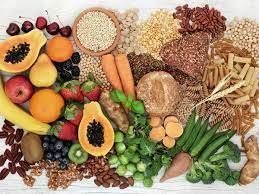
Diabetic, cholesterol level, blood pressure, gastro-intestinal diseases, and other chronic illnesses have risen among the people of Pakistan as dietary fiber intake is low.
Parkash Meghwar
Dietary fiber is a non-digestible carbohydrate, digested at large colon. It has two types – soluble and insoluble fiber. Soluble fibers are Porous, not absorbed in digest tract but absorb at colon after metabolism. These fibers lower the cholesterol and sugar level. Whereas, Insoluble fiber are non-porous, and regulate rate of transit of food. Pectin and gums are water soluble found inside the plant cells. Soluble fibers have been shown to increase cholesterol and lower blood glucose. Bran, oat bran, fruits and vegetables are good source of soluble fiber. Whereas whole grain, fruit, vegetables, and beans are good source of insoluble fibers. Fibers in cell wall are water insoluble, increases the fecal materials and speed up the passage of food through the digestive tract. Some are non-starch polysaccharides such as, Cellulose, pectin, hydrocolloids, gums, fructose-polysaccharides, and Inulin.
Dietary fibers are high in oats as compared to wheat. Recent research suggested that high fiber diet rich in whole grains associated with reduced risk of developing type 2-diabetes and obesity.
Dry fruit have low dietary fiber than fresh fruit as drying of food commodities can reduce the water holding capacity of dietary fiber. Also, removal of seed, peel and hull lower the dietary fibers. While whole tomatoes have high fiber as compared to peeled tomatoes.
Some functional fibers are Cellulose, chitin, beta-glucans, gums, inulin, oligo-fructose, fructo-oligosaccharides, lignin, pectin, psyllium, and resistant starch. Resistant starch is not digested by gut enzymes.
Pakistan is facing double burden of communicable and non-communicable diseases. According to NCDs risk factor survey revealed that 96.5% consuming unhealthy diet (WHO 2014).
Gums are good source of dietary fiber with characteristics like polysaccharides, bio-polymer, soluble in water, form a gel and mucilage, high molar mass, gelling characteristics, thickening, moisture retention, emulsification, stabilization. Gums can be derived from plant seeds like guar gum.
Dietary fibers are beneficial in treating or preventing constipation, hemorrhoids, diverticulitis, reduce blood cholesterol, regulation of appetite, metabolic process, chronic inflammatory pathways, long lasting weight loss, gut motility, helps to reduce irritable bowel syndrome, reduce HbA1c, improve glycemic index, control lipid profile, reduce risk of type-2 diabetes and CVD, normal immune development, release of various gut hormones and bile acids, colon health, protective role of intestine barrier, control cholesterol metabolism (Less than 200mg/dl cholesterol is associated with coronary heart disease), preservation of insulin sensitivity and reduce risk of chronic inflammation, depression, and mortality from cancer.
WHO recommended that 25g of dietary fiber per is required for female while 35g/day dietary fiber is required for male.
It is concluded that dietary fiber should be taken in diet as per recommendations to prevent the chronic health illnesses and ensure well-being.
I have observed that diabetic, cholesterol level, blood pressure, gastro-intestinal diseases, and other chronic illnesses have risen among the people of Pakistan as dietary fiber intake is low in the country and needs to be increased to mitigate the rising diseases.
_________________
 The author is student at Department of Food Science and Technology, University of Karachi. Email: kparkash707@gmail.com
The author is student at Department of Food Science and Technology, University of Karachi. Email: kparkash707@gmail.com